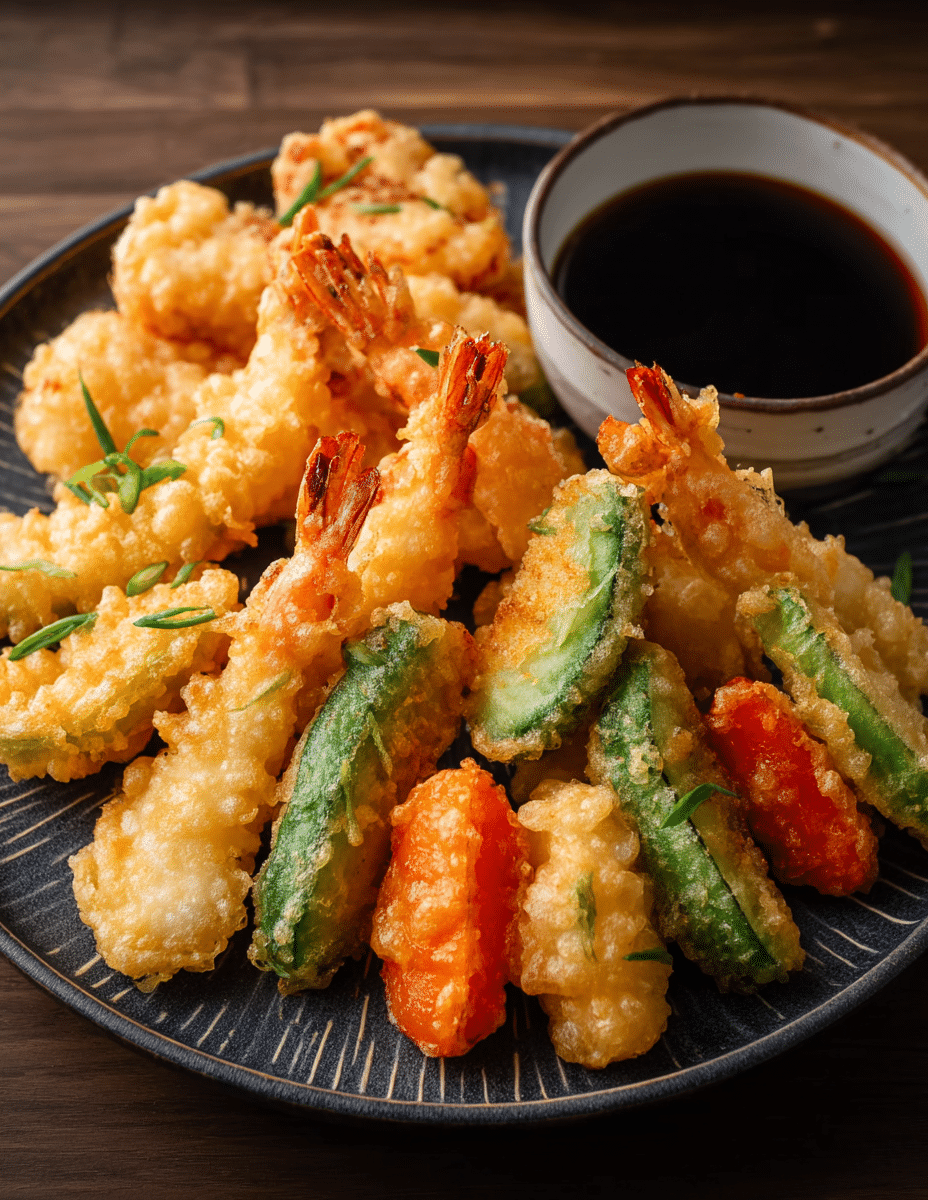This Japanese Tempura Batter delivers the classic light, crispy texture that makes tempura so beloved. Made with minimal ingredients—cold water, flour, and optionally egg or baking powder—it’s essential to maintain low temperature and resist overmixing for maximum fluffiness. Perfectly suited for seafood or vegetables, this batter ensures a delicate coating that doesn’t overpower the flavors of what you’re frying. With this method, your homemade tempura will closely resemble the airy, elegant fritters you’d enjoy at top Japanese restaurants.
Ingredients:
-
1 cup all-purpose flour
-
½ cup ice-cold water (sparkling water can be used for extra crispiness)
-
1 large egg (optional)
-
½ teaspoon baking powder (optional)
-
Salt, to taste
-
Assorted items for frying (e.g., sweet potato, zucchini, shrimp)
-
Neutral oil for frying (vegetable or canola oil)
Directions:
-
Prep Ingredients – Chop vegetables or seafood into uniform, bite-sized pieces for consistent cooking.
-
Combine Dry Mix – In a bowl, whisk together flour, baking powder (if using), and salt.
-
Mix Wet Ingredients – In a separate bowl, whisk egg (if using) and very cold water until lightly combined. Sparkling water adds extra airiness.
-
Make Batter – Gently pour the wet mixture into the dry ingredients and stir briefly using chopsticks or a fork. Some lumps are fine—do not overmix.
-
Heat Oil – Preheat oil in a deep pot to about 350 °F (175 °C).
-
Dip & Fry – Lightly dust ingredients with flour, then dip into the batter. Let excess drip off before carefully lowering into the oil. Fry in small batches for 2–3 minutes or until pale golden. Drain on paper towels.
-
Serve Immediately – Tempura is best enjoyed freshly fried, accompanied by tentsuyu dipping sauce if desired.
Nutrients:
-
Calories: 180 kcal
-
Fat: 5 g (Saturated 1 g)
-
Cholesterol: 47 mg
-
Sodium: 230 mg
-
Potassium: 130 mg
-
Carbohydrates: 28 g (Fiber 2 g, Sugars 1 g)
-
Protein: 5 g
-
Vitamin A: 150 IU
-
Vitamin C: 3 mg
-
Calcium: 20 mg
-
Iron: 1.0 mg
The Role of the Tempura Batter
The batter is the star of the tempura show, playing a significant role in achieving the characteristic lightness and crispiness of tempura. While tempura batters can vary in texture, all share a few common traits: lightness, crispiness, and a delicate texture that doesn’t overpower the ingredients being fried. The batter’s role is to provide a thin, crisp shell around the food, allowing the natural flavors of the seafood, vegetables, or meats to shine through.
Unlike typical deep-fried coatings, which tend to be heavy and thick, the Japanese tempura batter relies on a combination of simple ingredients, such as flour, water, and sometimes egg or baking powder, to create its trademark light texture. The key to a successful tempura batter is not just the ingredients but also the technique involved.
Ingredients in Tempura Batter
-
Flour: The base of any tempura batter, all-purpose flour is typically used. However, some recipes might suggest a combination of flour and cornstarch to further lighten the batter. This combination results in a crispier texture because cornstarch reduces the moisture absorption, which helps the batter crisp up better when fried.
-
Cold Water: The water used in the batter must be cold, ideally ice-cold, to prevent the flour from fully absorbing the liquid, which could result in a heavier, doughy batter. Cold water helps create a thin batter that crisps up during frying. Some recipes even call for sparkling water instead of regular water, as the carbonation adds extra airiness and crispiness to the batter.
-
Egg: While not always included, egg is a traditional addition that helps bind the ingredients together. Its presence results in a slightly richer batter. However, eggless versions of tempura batter are also quite popular, especially for those looking to avoid animal products.
-
Baking Powder: In some recipes, a small amount of baking powder is added to the batter to create additional fluffiness. The leavening agent works to expand the batter as it fries, resulting in an even lighter and airier texture. However, this is entirely optional, and many traditional tempura recipes omit this ingredient for a simpler batter.
-
Salt: A pinch of salt is often added to enhance the flavor of the batter. Though tempura is generally mild in flavor, the salt helps to bring out the natural sweetness of the fried ingredients.
Techniques for Perfect Tempura Batter
Creating the perfect tempura batter goes beyond just the choice of ingredients. Several techniques play a crucial role in achieving the signature light and crispy texture:
-
Cold Ingredients: As mentioned earlier, using very cold water is key. Cold ingredients prevent the batter from absorbing too much moisture and becoming dense. The cold temperature also causes the batter to fry quickly, ensuring a crispy texture. If you’re using sparkling water, ensure it’s chilled as well.
-
Minimal Mixing: When combining the wet and dry ingredients, the batter should be mixed minimally. Overmixing the batter can cause gluten to develop, resulting in a chewy and dense coating. Some lumps in the batter are perfectly fine—these help create the uneven texture that leads to crispiness.
-
Frying at the Right Temperature: The oil should be preheated to around 350°F (175°C). This high temperature is necessary to quickly fry the batter, creating a crispy exterior while keeping the inside of the ingredients tender and cooked. Too low of a temperature will cause the batter to absorb more oil, leading to a greasy, soggy texture. A thermometer is often recommended to ensure the oil stays at the right temperature.
-
Small Batches: It’s important not to overcrowd the frying pot. Frying too many pieces at once can cause the temperature of the oil to drop, resulting in soggy batter. Fry in small batches, and make sure to carefully lower the ingredients into the oil to avoid splattering.
-
Light Dusting of Flour: Before dipping ingredients into the batter, it’s a good idea to lightly dust them with flour. This helps the batter adhere more evenly and prevents it from sliding off during frying.
Common Tempura Ingredients
Tempura is incredibly versatile, and while seafood such as shrimp is the most well-known tempura filling, almost any ingredient can be tempura-fried. Some popular options include:
-
Seafood: Shrimp, white fish fillets, and squid are common choices for tempura. These ingredients benefit from the light batter, as it allows their natural flavors to stand out while providing a crispy exterior.
-
Vegetables: Common vegetables used in tempura include sweet potatoes, zucchini, mushrooms, bell peppers, and eggplant. Tempura vegetables are a delightful treat, especially when they retain a slight crispness while being perfectly tender on the inside.
-
Mushrooms: Shiitake and enoki mushrooms, as well as other varieties, are great for tempura because their delicate texture pairs wonderfully with the batter’s light crunch.
-
Meats: While not as traditional, meats like chicken or pork are sometimes used in tempura for those looking to create a more substantial dish.
Serving and Enjoying Tempura
Tempura is best served immediately after frying while it’s still hot and crispy. It’s traditionally accompanied by a dipping sauce called tentsuyu, which consists of dashi (a Japanese stock), soy sauce, and mirin. This sauce provides a savory contrast to the crispy batter.
Some people enjoy tempura with rice, while others prefer it as part of a multi-course meal. Tempura can also be paired with cold noodles, such as soba, for a refreshing contrast in textures. Tempura is often served in tempura restaurants, but it’s also a favorite for casual home meals and family gatherings.
Conclusion
Tempura is more than just a method of frying—it’s a delicate balance of ingredients, temperature, and technique that results in a light, crispy, and flavorful dish. Whether you’re cooking vegetables, seafood, or meats, the key to making the perfect tempura lies in mastering the batter. By keeping the ingredients cold, avoiding overmixing, and frying at the right temperature, you can create tempura that’s as crispy and delicious as what you’d find in top Japanese restaurants.
With a little practice and attention to detail, anyone can master the art of making tempura batter at home. The versatility of this dish makes it a perfect choice for a variety of occasions, from a casual dinner to a special celebration. So, gather your ingredients, heat up the oil, and enjoy the crispy delight of homemade tempura, made with the perfect batter!






